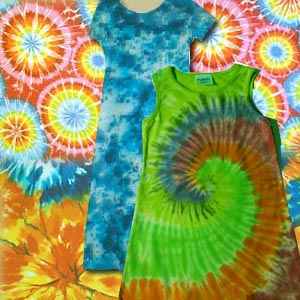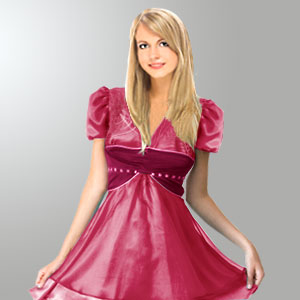Tie Dye Fabric

Tie dye fabrics are characterized by bold free-flowing prints and hues of striking colors. Use tie dye prints for T-shirts, pillowcases, bed sheets, curtains, furnishings...the possibilities are endless. What may have once been associated with the hippies is now a fashion statement, one that can be worn for a casual look. Tie dye fabric can be easily tried out at home. You can have fun playing around with different ties and folds and come up with exciting designs and motifs.
History of tie dye
Various tie-dye methods are used in different parts of the world. The Japanese tie-dye method is widely used for creating exquisite kimonos. Africa has its own version of tie dye fabrics. This ancient form of tie-dye is called Shibori and this can be later embellished with elaborate stitches.
West Africa, well known for indigo dye pits is home to rich tie-dye fabric that is further enhanced with traditional embroidery. In the Far East, Malaysia and Indonesia, the tie dye technique is called Plangi and Tritik. In India, tie and dye pattern is referred to as bandhani or bandhej.
Bandhani fabrics
Bandhani originates from the Sanskrit word 'banda' which means to tie. This type of tie dye fabric comes in a multitude of colors and is used extensively for bed linen, garments and furnishings. It is popular for daily wear apparel as well as festive sarees. You can pick up Bandhani sarees embellished with mirror work or gota work. Another variant is the Laheria - wavy pattern processed in the tie-dye technique. You will be spoilt for choice as bandhani material is available in a riot of colors.
Tie dye pattern
Basically tie dye method is a simple technique whereby the dye is prevented from reaching certain portions of the fabric by either tying or crumpling it. This leads to scintillating designs that make for an exciting art form. Since the inner layers of the fabric do not get dyed, it leads to patterns. This form of dyeing is also called resist dyeing.
The tie dye pattern is determined by the kind of tie that is applied on the fabric. Tie dyeing works best on natural fabrics such as cotton. Synthetic fabrics do not allow color to seep as well as cotton. Many a design can be incorporated with tie-dye methods. A popular pattern is that of bulls eye - where you can create a profusion of colorful rings in different dyes.
You can incorporate spirals by bundling up the fabric into a bun. This leads to differently colored wedges of cloth. Folding the fabric back and forth like a fan will give rise to stripes on your tie dye fabric. With a little bit of imagination, you can come up with many design options. You can use stones or nuts when you tie the fabric. Try tie-dyeing one pattern over another for a stunning burst of color.
Tie dye instructions
Small dots are tied to the fabric with threads, string, rubber bands or thin ropes. You can even use wires and dental floss. All you need is fabric, color dyes, fasteners and lots of imagination to get you going. Use a pair of gloves lest you stain your hands. Cover the work area with newspaper and put out a clothesline to dry your tie dye attempts. You can dye an entire garment or material in random prints.
Chaotic knots can lead to profusion of colorful designs. You can tie dye a t-shirt by tying it in knots with cords. Go in for random patterns all over. The dye must be enough to soak the material thoroughly. The choice of color combinations is left to your imagination. Allow the tie dyed fabric to dry completely.
You can pick up tie-dye kits that will allow you to let your imagination run riot at home. Always work from the lightest color up to the darkest. Wash the fabric before you begin so that the dye penetrates well. Ensure that the fabric is completely dry before embarking on tie-dye patterns. From tablecloths to curtains and aprons, you can go berserk with tie-dyeing.
Top of the Page: Tie Dye Fabric
Tags:#tie dye #tie dye shirt #tie dye instructions #tie dye pattern #tie dye fabric
 Shopping Guide
Shopping Guide How to Dress Slimmer
Petite Dresses
Lace Sheath Dress
Dressy Tops for Women
Pea Coats for Women
Church Suits
Cocktail Dress
Little Black Dress
Prom Dress
Semi Formal Dress
Women's Skirt
Women's Fashion - Women's Apparel
Fashion Apparel for Women
Tummy Tuck Jeans
Women Designer Jeans
Tank Tops
Cashmere Sweater
Mohair Sweater
Winter Wedding Dress
Summer Wedding Dress
Winter Boots
Winter Coat
Dress for Bride's Mother
Baby Christening Gown
Silk Scarf
Pashmina Scarves
Halter Dresses
Women Undergarments
 Sheer Camisole
Sheer Camisole Underwire Bra
Body Shapers for Women
Women's Undergarments
Sheer Lingerie
Women Sleepwear
Women Casual Wear
 Travelling Clothes for Women
Travelling Clothes for Women Fall Wedding Colors
Fall Fashion Trend
Jogging Clothes
Leggings
Tights
Parka
Corset
Summer Clothes
Summer Dress
Summer Long Dress
Sundresses
Vintage Evening Dress
Wedding Veil
Beach Wedding Dress
Women's Hosiery
Nylon Stockings
Maternity Apparel
Maternity Jeans
Athletic Apparel
Leather Apparel for Women
Indian Saree Shopping
How to wear a Saree
Halloween Costume
Womens Tunic Dress
Sequin Dresses
Wrap Dress
Charmeuse Dress
Ruffle Dress
Top of the Page: Tie Dye Fabric
Popularity Index: 101,496

